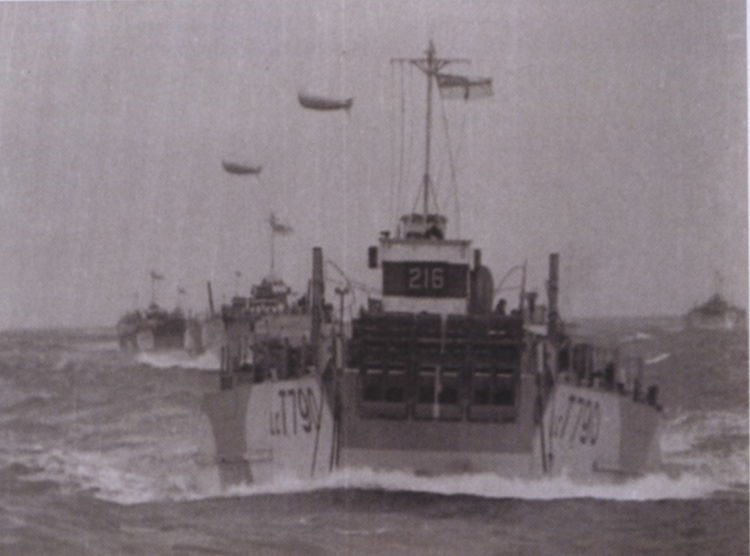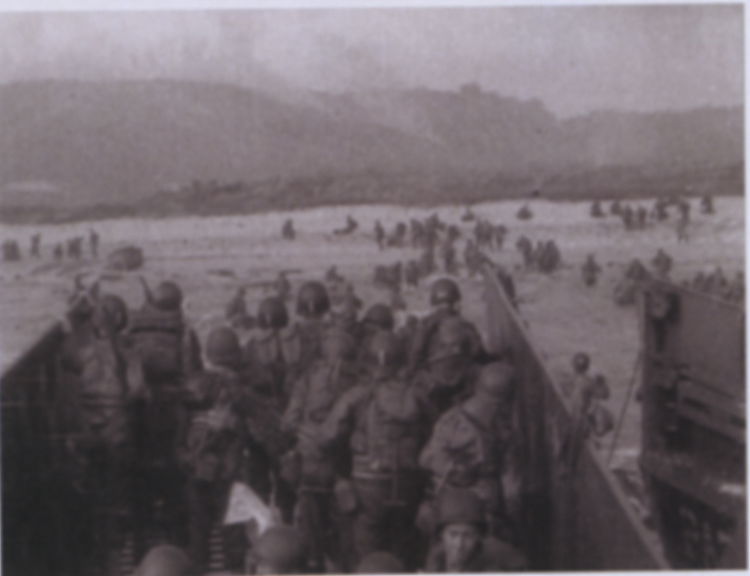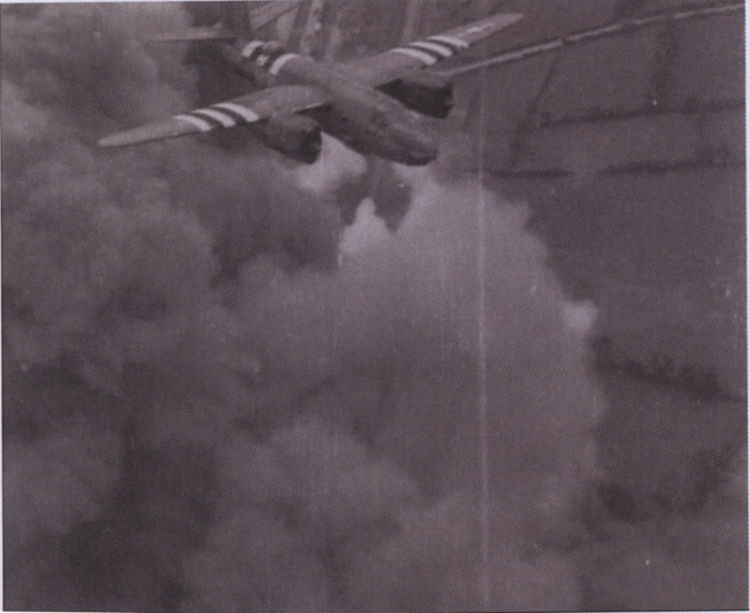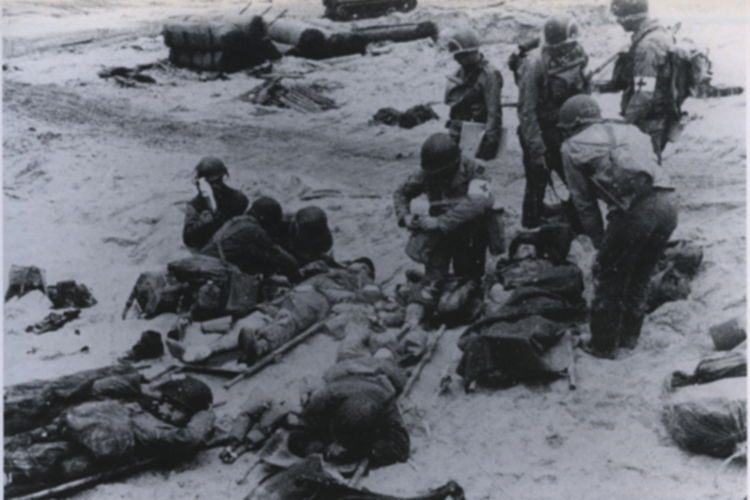Picturing D-Day
Michael Paris examines the way in which aspects of D-Day were filmed at the time and have subsequently been reconstructed in popular cinema.
The Second World War might be described as a film-makers' war, for almost every significant moment was filmed by combat cinematographers and released to the newsreels, edited into an official documentary, or reconstructed in the studio as dramatic narrative. The Allied invasion of Europe, Operation Overlord, which opened on June 6th, 1944, with the landings on the Normandy coast, was no exception. D-Day was arguably the most important event of the war - the opening of the final phase of the conflict. Failure to get troops ashore to establish a secure beachhead would have set back the Allied cause and so undermined morale that such an operation might have been abandoned. Clearly, the outcome of the war largely depended upon what happened on the Normandy beaches. The events of D-Day have been thoroughly detailed by historians, but how have film-makers, from combat film units that accompanied the invasion force to Hollywood producers such as Darryl F. Zanuck and Steven Spielberg, dealt with this dramatic moment?
 Overlord was the largest and most complex military operation ever undertaken. Involving some 170,000 Allied troops and vast amounts of equipment, the invasion fleet comprised 4,000 ships and several thousand smaller craft. Providing air cover for the armada, transporting airborne troops or attacking enemy defences and communications behind the beachheads involved over 12,000 aircraft. The need to invade Hitler's Europe had been first mooted in 1940 when Winston Churchill, humiliated by Dunkirk, optimistically dreamed of the day when the British and their allies would return to mainland Europe. That day came a little closer in 1941 when first the Soviet Union and then the United States became Britain's allies. But before the onslaught on Hitler's 'Fortress Europe' could take place, the Allies had first to secure the Mediterranean, defeat the U-boat menace in the Atlantic so that American troops and equipment could reach the invasion launchpad in southern England, and gain control of the air over the Channel and northern France, By 1944 those conditions had largely been met; but while the preparations for Overlord had been meticulous, invasion was still a risky business. The disaster of the Dieppe raid in 1942, which had seen over 50 per cent casualties among the attackers, cast a long shadow over the planning and was a constant reminder of just how dangerous such seaborne invasions could be. On the evening of June 5th, Field Marshall Alan Brooke, Chief of the Imperial General Staff, confided in his diary,
Overlord was the largest and most complex military operation ever undertaken. Involving some 170,000 Allied troops and vast amounts of equipment, the invasion fleet comprised 4,000 ships and several thousand smaller craft. Providing air cover for the armada, transporting airborne troops or attacking enemy defences and communications behind the beachheads involved over 12,000 aircraft. The need to invade Hitler's Europe had been first mooted in 1940 when Winston Churchill, humiliated by Dunkirk, optimistically dreamed of the day when the British and their allies would return to mainland Europe. That day came a little closer in 1941 when first the Soviet Union and then the United States became Britain's allies. But before the onslaught on Hitler's 'Fortress Europe' could take place, the Allies had first to secure the Mediterranean, defeat the U-boat menace in the Atlantic so that American troops and equipment could reach the invasion launchpad in southern England, and gain control of the air over the Channel and northern France, By 1944 those conditions had largely been met; but while the preparations for Overlord had been meticulous, invasion was still a risky business. The disaster of the Dieppe raid in 1942, which had seen over 50 per cent casualties among the attackers, cast a long shadow over the planning and was a constant reminder of just how dangerous such seaborne invasions could be. On the evening of June 5th, Field Marshall Alan Brooke, Chief of the Imperial General Staff, confided in his diary,
It is very hard to believe that in a few hours the cross-Channel invasion starts! I am very uneasy about the whole operation. At the best it will be so very, very far short of the expectation of the bulk of the people ... At the worst it may well be the most ghastly disaster of the whole war. I wish to God it were safely over.
Overlord, however, wasn't the 'ghastly disaster' Brooke had feared, and within hours of the landings the forces were ashore and ready to advance on their first objectives. Only on Omaha Beach, in the American zone, did the Allies face heavy opposition, but even here they eventually broke through. News of the invasion came from the BBC at 9.32am:
This is London. London calling in the Home, Overseas and European services of the BBC and through United Nations Radio Mediterranean, and this is John Snagge speaking.
Supreme Headquarters Expeditionary Force have just issued Communique Number One.
 Under the command of General Eisenhower, Allied naval forces, supported by strong air forces, began landing allied armies this morning on the northern coasts of France.
Under the command of General Eisenhower, Allied naval forces, supported by strong air forces, began landing allied armies this morning on the northern coasts of France.
British cinema audiences were presented with the first newsreel reports of the invasion a few days later, on June 8th, though these only showed shots of the preparations and of the invasion fleet setting sail. Gaumont British News, British Movietone and Pathe Gazette were all released on the same day and used much the same footage. Under the heading 'The Hour of Liberation', Gaumont British reported the communique from Supreme Headquarters and showed Churchill's visit to the invasion ports, paratroopers preparing their equipment and a night bombardment of a distant coastline. The commentary pointed out it was 'four years to the very month, since we were hurled off the Continent of Europe', a reference to the evacuation from Dunkirk that was picked up in most of the other newsreels. Pathe Gazette's report even included a short sequence of the 1940 evacuation. Pathe used similar footage of Churchill's visit to the invasion fleet and a close-up of Eisenhower communique, but told its audience that while these were the 'first pictures of the opening of the second Front', security demanded they should be 'meagre at this stage'. However, the commentary went on to point up the significance of the moment:
Four years ago Europe was Hitler's. The lights of freedom went out. Now the world of free men strikes in all its assembled might at the weakening chains of bondage.
But while these first reports captured something of the excitement of the moment, they offered little detail of the actual landings. Audiences had to wait a week until the first pictures of these were screened; and even then they were somewhat impersonal.

The most dramatic was the June 15th issue of Pathe Gazette, under the title 'Invasion Pictorial Reports From France'. The opening shot, taken from the rear of a British landing craft packed with troops by a camera mounted at the back of the vessel and operated automatically, shows the craft approaching a French beach; the doors open and the soldiers disembark; one places his hand on another's shoulder in a gesture of comradeship. The staccato commentary reinforces the drama,
French rooftops over the bows of allied landing craft beaching on the Normandy shore. There comes the grinding of keels on shingle and our troops spill ashore across that open stretch menaced by enemy gunfire. Newsreel and Allied service cameramen go in with the landing forces. The pictures they take make up this lengthened edition of Pathe Gazette.
While the commentary creates a sense of immediacy, the report seems to combine the initial landing with footage taken later. The second scene is taken from further up the beach, looking back to the disembarking troops; one soldier appears to stumble and fall, suggesting, though not actually showing, enemy resistance. However, the scene is immediately followed by others which undermine the intensity: tanks and heavy equipment being brought ashore, the camera lingering on wrecked enemy gun emplacements, and finally Montgomery posing for the cameras before overseeing the advance inland. But even this report had none of the dramatic pictures of combat that audiences had come to expect from war films: shells exploding, men fighting and wounded, the burnt-out tanks and the shattered debris of the battlefield. But here the landing was presented as a sanitised, successful but almost mechanistic event.
While the British newsreels celebrated the success of the invasion, albeit playing down the human cost, German newsreels tried to ignore June 6th altogether. News of the invasion was long delayed and when newsreels were finally released they were selective in their portrayal of events. German cameramen had had little opportunity to film the actual landings, thus the report from Die Deutsches Wochenshau, the official German newsreel, issued on July 20th, largely comprising old footage accompanied by a confident narration that suggested that the invaders were being contained and that their losses had been heavy. These claims were reinforced by scenes of abandoned Allied landing craft, wrecked gliders, and shots of dazed and wounded prisoners - probably Canadians captured during the disastrous raid on Dieppe in 1942. Much of this footage had already been used in late June by France Actualites, the official newsreel of Occupied France. The commentary stressed that not only were the British and Americans being contained but that they were causing great suffering for the French people through the bombardment of Norman towns. During footage of a devastated town, the commentator claims:
... Every minute Frenchmen are dying and French homes crumble to dust. How many other Norman cities are now ghost towns or cemeteries?
The message was clear, the Allies had no concern for innocent French civilians or their property - were these pitiless men really the noble liberators of France?
Film, however, can offer far more than a simple visual record, and its real popularity hinges on the manner in which audiences are drawn into the unfolding narrative, to identify with the characters and to 'share' their experience. British audiences may well have wanted to share the ' drama and the danger of the invasion through the moving image, but they were offered only short newsreel reports. The invasion story had moved on to the advance into the German heartland before more dramatic footage was made available. As far as the newsreel companies were concerned, the experiences of june 6th were by then Old' news. A more detailed film record of D-Day was not released by the Ministry of Information until the summer of 1945. In the autumn of 1944, however, audiences were offered a film version of an earlier invasion of Normandy Laurence Olivier's lavish allegory, Henry V. This film had taken over a year to complete but was premièred on November 22nd, and dedicated 'To the Commandos and Airborne Troops of Great Britain, the Spirit of our Ancestors'. Olivier had carefully copied the text into a screenplay that reflected the mood of the time. It presented Henry as a 'man of the people with a Churchillian resonance', in the words of historians Whelehan and Cartmell. Olivier cut 1,700 lines from the play, including the threats made to the people of Harcourt, the order to execute the French prisoners, and the (!horns' finale which informs the audience that Henry's heir subsequently 'lost France and made England bleed'. Olivier's version omitted a great deal from the play but it added the beautifully choreographed scenes of the Battle of Agincourt, in which the sturdy English and Welsh archers cause such slaughter among the heavily armoured French knights. It was a triumphant variation on the invasion theme and one through which audiences could, to some extent, share the experience of an invading army.
From autumn 1944 British documentary films about D-Day began to appear. Both Towards the Offensive (1944) and The Air Plan '(1945) detailed the RAF's preparations for D-Day and the battle for air supremacy; A Harbour Goes Lo France (1945) told the extraordinary story of the Allies' floating Mulberry harbour. But the most important of these was The True Glory - the official Anglo-American documentary record of D-Day and the subsequent campaign in Europe - and one of the most powerful of all feature-length wartime documentaries. Directed by Carol Reed and the American Garson Kanin, the film's commentary was clearly influenced by Olivier's production. Originally intended to cover only the Normandy campaign, inter-service rivalries and disagreements between the British and American production teams delayed the project. In October 1944 it was decided to extend the film to cover subsequent events up to Germany's surrender. Consequently it was not completed until the summer of 1945.

The film was introduced by General Eisenhower who emphasised that the focus was on the 'really important men in this campaign, the enlisted soldiers, sailors and airmen' - and the film docs precisely that by relating what happened to these ordinary men at key points in the campaign. A Shakespearean commentary in blank verse links these episodes of personal experience and creates a sense of the past impacting upon the events witnessed on the screen. Over a hand-drawn map of the Channel coast, the commentary explains:
We planned to breach the wall and smash the German spine, but where?
We searched the coast of Europe like fierce eagles,
Between low Flushing and deep-harboured Cherbourg,
Our eyes sought out the place of the assault...
Until finally 'All resolved on Normandy, on Caen',
So on five miles of still unbloodied sand, the fretful course of fate would be assailed by armoured nations.
The film sequences dealing with June 6th combine footage from Allied service cameramen and captured German footage, and provide the backdrop for the personal testimonies of participants, delivered in everyday language by a variety of voices and in counterpoint to the high rhetoric of the verse narrative. Indeed, it is surprising that men who have so recently been a part of this enormous but dangerous enterprise can be so matter-of-fact about their experiences. For example, a Scottish soldier relates how on Gold beach,
It wasn't too bad getting ashore. After that it started, we had to fight for every bloody field. And it was the same each time; crawling on your belly, keeping your backside down like you'd been told, chucking a few grenades then rush them. Sometimes they killed us, but we were killing more of them...
The True Glory made a valiant attempt to record the personal experiences of those taking part in D-Day. Audiences found it far more absorbing than the usual documentaries issued by the Ministry of Information, and closer to the American films that offered a more personal view of the invasion and contained footage shot by Hollywood luminaries such as George Stevens and John Ford. Nevertheless it was still in a stylised, semi-official form, far removed from the narrative films that audiences looked to in order to experience how such momentous events impacted upon the individual soldier, sailor or airman. Thus, when feature films about D-Day began to appear in the post-war years, they proved enormously popular.
D-Day provides the baptism of fire for an infantry company, to D-Day the Sixth of June (1956), which focused more on a love triangle between a British officer's wife and an American correspondent than on the events of the invasion. The two most important contributions were Darryl Zanuck's 1962 blockbuster The Longest Day, taken from the epic oral history by journalist Cornelius Ryan, and Steven Spielberg's Saving Private Ryan (1998).
The Longest Day deals with the twenty-four hours of the landings through a series of vignettes - the Americans fighting ashore on Omaha, British airborne troops securing the Pegasus Bridge, Free French troops liberating Ouistreham, the reaction of the German defenders, and so on. While criticised for sacrificing historical accuracy in favour of cinematic spectacle, the film provided a visually exciting reconstruction of the events of June 6th. But, as Newsweek soon pointed out, the problem with attempting to cover such a vast canvas was that the individual became almost incidental in a film where D-Day itself was the only real subject. However, the individual's experience of June 6th was the focus of Saving Private Ryan. The critically acclaimed and brutally realistic opening scene where Captain John Miller's (Tom Hanks) infantry company attempts to wade ashore on Omaha Beach offers the most accurate reconstruction we have of the impact of combat on the individual soldier. The emphasis on personal experience was seen again in Spielberg's subsequent television series band of Brothers. These efforts to reconstruct D-Day emerged from Hollywood and, while they have made considerable use of British directors and actors, their main focus has been the American experience. This has resulted in the usual silly claims in the British press that the Americans have written out the part played by the British and other allies. However, both of these productions try to reconstruct the experience of individual men in battle an experience shared by all combatants on June 6th. They have powerfully demonstrated just how terrible that experience could be.




